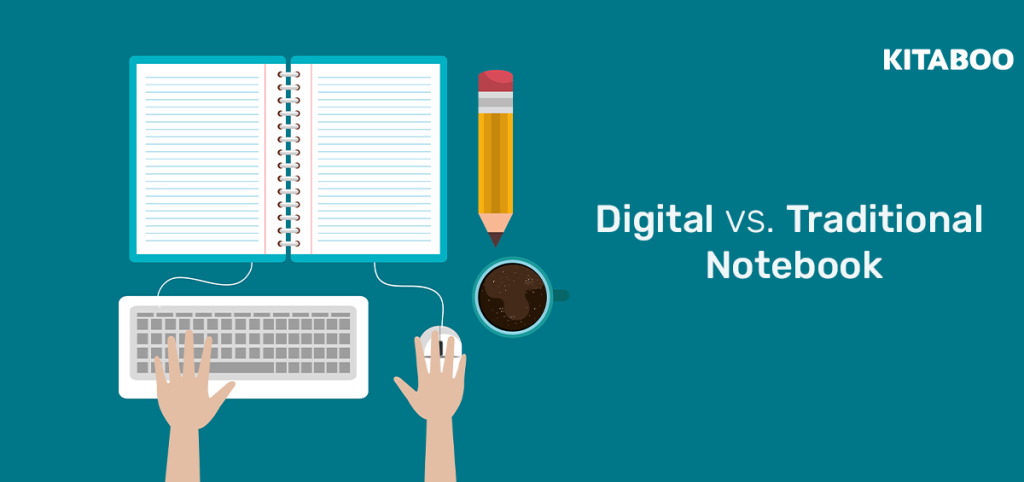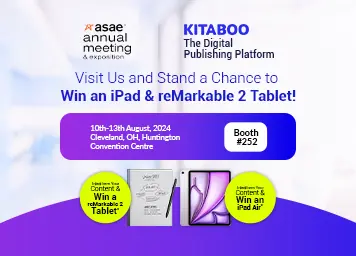
Digital Notebooks vs. Traditional Notebooks: Which One is the Winner?
Answering which of the two notebooks is better — digital or traditional — is like answering the million-dollar chicken and egg question. When the Ancient Greeks developed ‘hypomnema’, which were personal records on essential subjects, humankind had only begun scratching the surface (literally!) of what notetaking could do.
The Renaissance period only made this method famous, especially for learning and memory, which is one of the constants in our lives today.
With technology and eLearning becoming a part of our lives, strengthened by the COVID-19 pandemic, digital notebooks have become as popular as traditional ones. And rightly so, because of the multiple advantages it offered.
Companies like KITABOO developed outstanding digital publishing and eBook solutions to support this shift, showing how the digital revolution was here to stay.
As the debate rages on about digital notebooks vs. traditional notebooks, we’ve got an unbiased comparison for you to decide for yourself.
Table of Contents
I. Digital Notebooks vs Traditional Notebooks: 10 Points of Comparison
- Convenience
- Security & Privacy
- Accessibility
- Sharing & Collaboration
- Add-ons & Media
- Grasping & Processing
- Speed
- Pricing
- Environmental Impact
- Syncing, Search & Organization
III. Write, Right
I. Digital Notebooks vs Traditional Notebooks: 10 Points of Comparison
1. Convenience
Digital notebooks are more convenient than traditional ones in multiple ways. They are highly portable — the same files can be opened on laptops, mobiles, or any other device.
You can carry various digital notebooks without increasing your bag’s weight, especially when traveling. You can access your notes anytime, anywhere, with just a click of a button.
Win: Digital Notebooks
2. Security & Privacy
This is a tough one. While digital ones can have anti-virus software, encryption, and passwords, they can be prone to hacking or data breaches.
Traditional notebooks, however, provide no privacy or data security in any form unless you lock them up.
Win: Tie
3. Accessibility
Traditional notebooks are not meant for those with disabilities; they are restrictive. Digital ones are meant for EVERYONE. If you are visually impaired, you can narrate your notes with speech-to-text features.
You can also adjust the contrast font sizes, install a Braille display, use gestures, highlight, change the input methods, etc. It also has auto-correct features, multi-language support, and other customization options.
Win: Digital Notebooks
4. Sharing & Collaboration
It’s easy to collaborate with a group of people when taking digital notes and working in real-time, with date and time stamps. They also allow for remote collaboration, have options for feedback, and can be integrated with other tools like project management apps, etc.
Handwritten notes come with challenges when it comes to sharing and don’t offer seamless collaboration.
Win: Digital Notebooks
5. Add-Ons & Media
Let’s take an example of a student taking notes in a class. The teacher drew a diagram that wasn’t in the textbooks. Someone using the digital notes feature can click a picture and insert it in the text immediately for future reference.
With traditional notebooks, this is a painstaking process. Notebooks that are digital also allow for adding other kinds of media like videos, audio, and presentations that help recall and enhance the experience.
Win: Digital Notebooks
6. Grasping & Processing
A recent study found that those who took paper notes performed as well as those who took digital notes when it came to recall. But when it was about answering cognitive questions, those who took paper notes outshined the others.
Win: Traditional Notebooks
7. Speed
Typing or narrating is faster than using your hand to write. However, research has found that this speed in digital notetaking leads to typing down the notes verbatim as opposed to handwritten notes, where you focus and note down only the most important things.
Win: Tie
8. Pricing
There are two ways to look at the cost factor. One is the initial investment, where digital notebooks are more expensive, and two is the long-term savings, where physical notebooks can be more expensive.
The reusability of notebooks that are digital is high, which makes its long-term cost come down.
Win: Tie
9. Environmental Impact
Paper notebooks have one obvious flaw, which is the cutting of trees to make paper. Paper and pulp industries have a massive impact on the forests, according to WWF. And recycled paper notebooks are not preferred as much as the others.
Paper notebooks also generate more waste but are largely biodegradable. When you look at the entire lifecycle of digital vs. paper notebooks, the digital ones are less detrimental to the environment.
Win: Digital Notebooks
10. Syncing, Search & Organization
This is where digital notebooks excel the most. They allow you the option to search through your notes, back them up, and sync across devices so you never lose your hard work.
Water, fire, or any other kind of damage doesn’t harm them because they are backed up on the cloud. You can also effortlessly organize your notes by creating labels, folders, sub-notebooks, etc.
Win: Digital Notebooks
II. What Does Research Say?
A recent study conducted by researchers from South China University used two tests to understand the impact of a digital notebook vs. a traditional one. After the analysis, it was concluded that “overall, the user experience of using a digital notebook is superior to a paper notebook.”
Paper notebooks had advantages for better understanding and comprehension, but digital notebooks offered the convenience and ease of recording different types of media.
A University of Michigan study spoke directly to students and found that 53% of the respondents found that digital note taking on their laptops was helpful, and 25% thought it increased their attentiveness.
III. Write, Right
After reading this article, we’d love for you to make an informed choice. If you enjoy the pen-to-paper experience or simply the smell of paper, you can reap its benefits!
But if you want the cacophony of the keys or the symphony of the stylus, we urge you to explore the world of what digital notebooks can do. It’s limitless.
Cutting-edge platforms, like KITABOO, are helping to create impressive learning outcomes through eBooks, AI, and other end-to-end digital publishing solutions. Combined with digital note taking, it can completely redefine your learning experience, making it more constructive, interactive, and fun.
Explore KITABOO to see what we are talking about now!
Contact our expert team now and get started!
To know more, please write to us at KITABOO@hurix.com
Discover how a mobile-first training platform can help your organization.
Kitaboo is a cloud-based platform to create, deliver & track mobile-first interactive training content.






